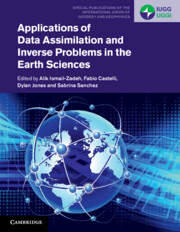Book contents
- Applications of Data Assimilation and Inverse Problems in the Earth Sciences
- Series page
- Applications of Data Assimilation and Inverse Problems in the Earth Sciences
- Copyright page
- Contents
- Contributors
- Preface
- Acknowledgements
- Part I Introduction
- Part II ‘Fluid’ Earth Applications: From the Surface to the Space
- Part III ‘Solid’ Earth Applications: From the Surface to the Core
- 11 Trans-Dimensional Markov Chain Monte Carlo Methods Applied to Geochronology and Thermochronology
- 12 Inverse Problems in Lava Dynamics
- 13 Data Assimilation for Real-Time Shake-Mapping and Prediction of Ground Shaking in Earthquake Early Warning
- 14 Global Seismic Tomography Using Time Domain Waveform Inversion
- 15 Solving Larger Seismic Inverse Problems with Smarter Methods
- 16 Joint and Constrained Inversion as Hypothesis Testing Tools
- 17 Crustal Structure and Moho Depth in the Tibetan Plateau from Inverse Modelling of Gravity Data
- 18 Geodetic Inversions and Applications in Geodynamics
- 19 Data Assimilation in Geodynamics: Methods and Applications
- 20 Geodynamic Data Assimilation: Techniques and Observables to Construct and Constrain Time-Dependent Earth Models
- 21 Understanding and Predicting Geomagnetic Secular Variation via Data Assimilation
- 22 Pointwise and Spectral Observations in Geomagnetic Data Assimilation: The Importance of Localization
- Index
- References
14 - Global Seismic Tomography Using Time Domain Waveform Inversion
from Part III - ‘Solid’ Earth Applications: From the Surface to the Core
Published online by Cambridge University Press: 20 June 2023
- Applications of Data Assimilation and Inverse Problems in the Earth Sciences
- Series page
- Applications of Data Assimilation and Inverse Problems in the Earth Sciences
- Copyright page
- Contents
- Contributors
- Preface
- Acknowledgements
- Part I Introduction
- Part II ‘Fluid’ Earth Applications: From the Surface to the Space
- Part III ‘Solid’ Earth Applications: From the Surface to the Core
- 11 Trans-Dimensional Markov Chain Monte Carlo Methods Applied to Geochronology and Thermochronology
- 12 Inverse Problems in Lava Dynamics
- 13 Data Assimilation for Real-Time Shake-Mapping and Prediction of Ground Shaking in Earthquake Early Warning
- 14 Global Seismic Tomography Using Time Domain Waveform Inversion
- 15 Solving Larger Seismic Inverse Problems with Smarter Methods
- 16 Joint and Constrained Inversion as Hypothesis Testing Tools
- 17 Crustal Structure and Moho Depth in the Tibetan Plateau from Inverse Modelling of Gravity Data
- 18 Geodetic Inversions and Applications in Geodynamics
- 19 Data Assimilation in Geodynamics: Methods and Applications
- 20 Geodynamic Data Assimilation: Techniques and Observables to Construct and Constrain Time-Dependent Earth Models
- 21 Understanding and Predicting Geomagnetic Secular Variation via Data Assimilation
- 22 Pointwise and Spectral Observations in Geomagnetic Data Assimilation: The Importance of Localization
- Index
- References
Summary
Abstract: In this chapter, I present an overview of waveform tomography, in the context of imaging of the Earth‘s whole mantle at the global scale. In this context, waveform tomography is defined utilising entire wide-band filtered records of the seismic wavefield, generated by natural earthquakes and observed at broadband receivers located at teleseismic distances. This is in contrast to imaging methodologies that first extract secondary observables, such as, most commonly, travel times of the most prominent energy arrivals (i.e. seismic phases), that can be easily identified and isolated in the records. Waveform tomography is a non-linear process that requires the ability to compute the predicted wavefield in a given three-dimensional Earth model and compare it to the observed wavefield. One of its main challenges, is the computational cost involved. I first review the history of methodological developments, specifically focusing on the global, whole mantle Earth imaging problem. I then discuss and contrast the two recent methodologies that have led to the development of the first three-dimensional elastic global shear velocity models that have been published to-date using numerical integration of the wave equation, specifically, using the spectral element method. I discuss how the forward problem is addressed, the data selection approaches, definitions of the misfit function, and computation of kernels for the inverse step of the imaging procedure, as well as the choice of the optimisation method. I also discuss model parametrisation, and, in particular, the important topic of how the strongly heterogeneous crust is modelled. In the final parts of this chapter, I discuss efforts towards resolving the difficult problem of model evaluation and present my views on promising directions and remaining challenges in this rapidly evolving field, aiming at further improving resolution of deep mantle elastic structure with the goal of informing our understanding of the dynamics of our planet.
Keywords
- Type
- Chapter
- Information
- Publisher: Cambridge University PressPrint publication year: 2023
References
- 2
- Cited by

